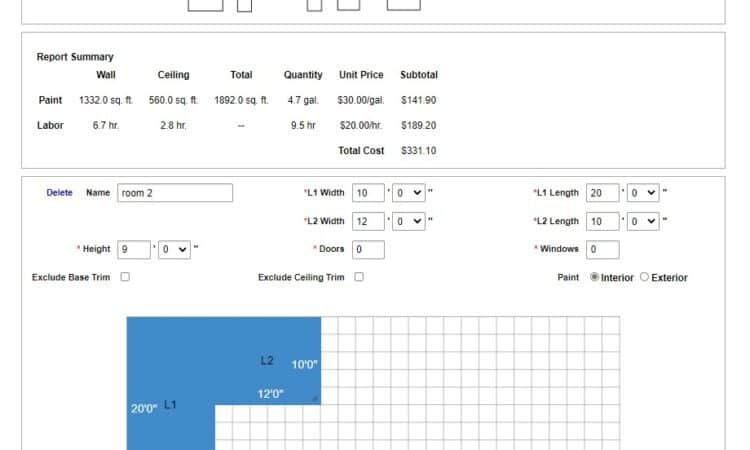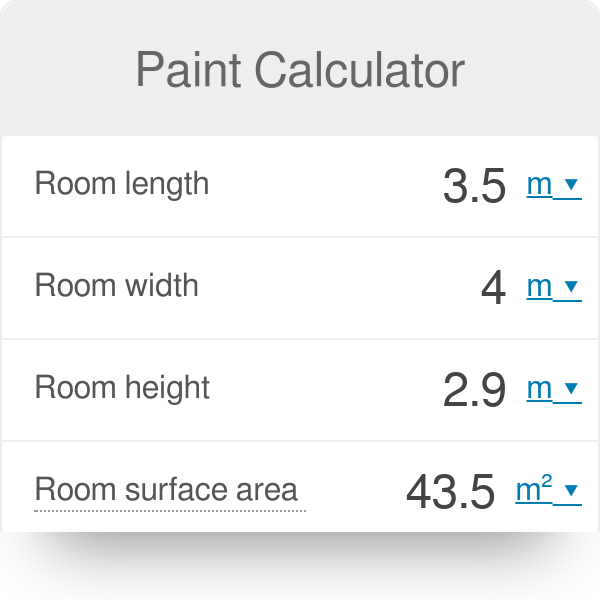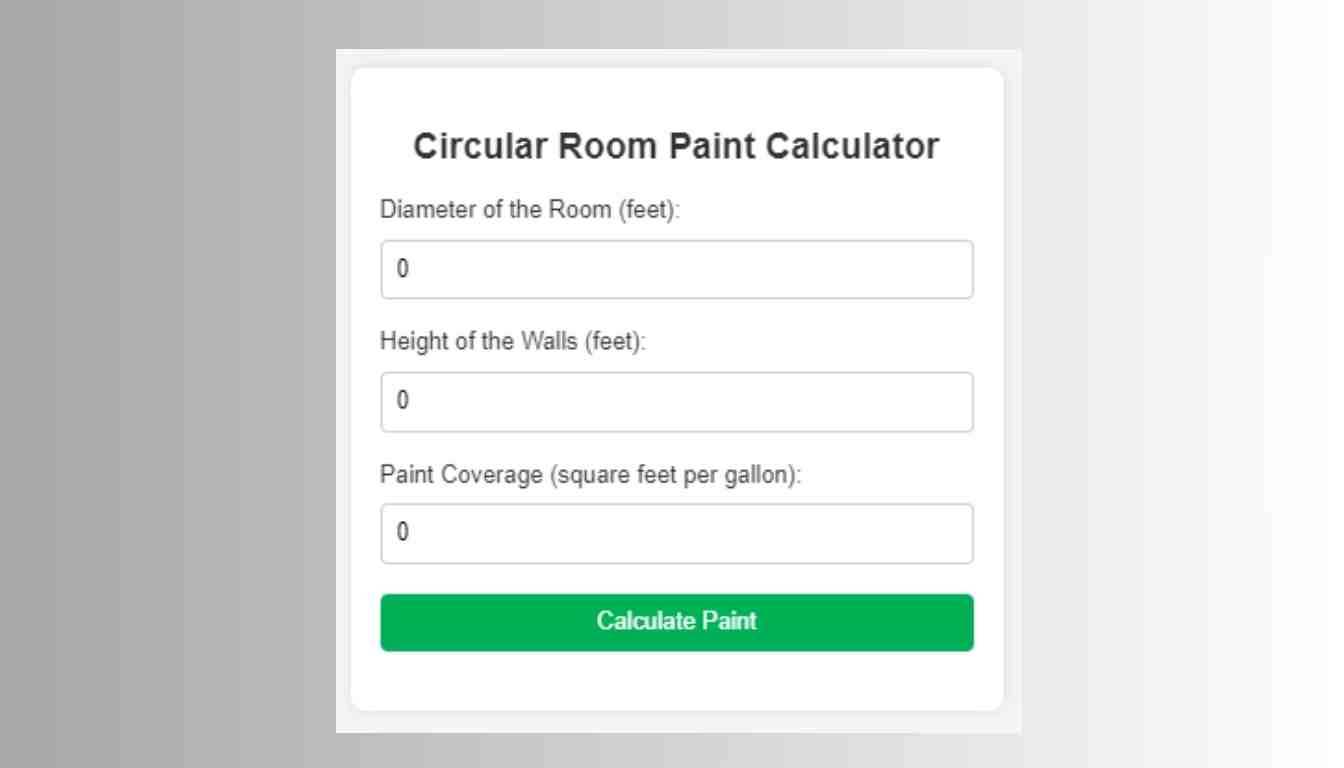To calculate paint for a circular room, you need the room’s height and circumference. Use these measurements to determine the total wall area to be painted.
Circular Room Paint Calculator
Calculating the amount of paint required for a circular room starts with understanding the unique shape of the space. Unlike traditional rectangular rooms, a circular room’s walls form a continuous curve, which can be challenging when determining the exact area to cover.
Homeowners, DIY enthusiasts, and professional painters looking to embark on a painting project will find that precision is key to avoid under or overestimating the amount of paint needed. Getting this right saves time, money, and effort, ensuring a seamless painting process. Keep in mind that paint calculations should also consider the number of coats required and the paint’s coverage rate as indicated by the manufacturer. This preliminary and crucial step will lead to a successful and efficient decorating outcome, leaving your circular room with a fresh and even coat of paint.
Introduction To Circular Room Painting
Painting a circular room adds a unique charm to your home. Circular spaces pose a delightful challenge that excites the imagination and inspires creativity. The shape requires special attention to both aesthetics and mathematical precision. Grasping the nuances of painting circular structures ensures a stunning effect and a flawless finish.
The Aesthetics Of Round Spaces
Round rooms break the conventional mold of living spaces. They offer a 360-degree panorama that conventional square or rectangular rooms can’t match. Focal points and lighting play differently here, creating a dynamic experience. To maximize the beauty of a circular room:
- Choose colors that enhance the room’s natural curves.
- Consider using accent walls to highlight architectural features.
- Select finishes that complement the room’s unique lighting.
Importance Of Accurate Paint Calculations
Accuracy in paint calculations prevents waste and ensures cost-effectiveness. With round rooms, this task becomes more complex. Correct measurements are critical for a successful painting project. An accurate paint calculator:
- Takes the room’s height and circumference into account.
- Factors in the number of doors and windows.
- Adjusts for multiple coats, if necessary.
By using a Circular Room Paint Calculator, you can nail down the precise amount of paint needed. This tool saves time, money, and effort in the long run.

Credit: measuresquare.com
Basic Geometry Of Circular Rooms
Decorating any room requires a plan, especially circular rooms with their unique shapes. It’s essential to understand their geometry to calculate paint needs accurately. This post will clarify how to work out the space in circular rooms for painting projects.
Understanding Circumference And Area
Before we dive into calculations, let’s break down the geometry of circular rooms. The circumference is the total distance around the room’s edge. The area is the space within the circular floor. Knowing both figures is crucial for paint calculations.
- Circumference (C) is calculated with the formula C = 2πr, where ‘r’ is the room’s radius and π (pi) is approximately 3.14.
- Area (A) is found by the formula A = πr², which also requires the room’s radius.
Walls And Dome Ceilings
When painting a circular room, consider both walls and any dome ceilings. A room’s wall area is determined by the formula (Wall Area = Circumference × Wall Height). For dome ceilings, the surface area is a segment of a sphere, and calculation can be tricky.
| Element | Formula |
|---|---|
| Wall Area | Circumference × Wall Height |
| Dome Ceiling Area (approx.) | 2πr × (0.5r) |
Always use these formulas to figure out the total paintable surface. Remember to measure your room’s radius and height accurately for the best estimate. With these basics, a Circular Room Paint Calculator helps transform these measurements into the amount of paint needed.
Paint Calculation Essentials
Imagine turning a circular room into a masterpiece with the perfect shade of paint. Before dipping your brush into the paint can, you must figure out how much paint to buy. Let’s look at key elements for calculating paint for a circular room.
Units Of Measurement
To start, measure your room’s dimensions. You need the radius (half the width of your circular room) and the height of the walls. For paint calculations, we use feet or meters. Record your dimensions in either:
- Feet (ft) for the US customary system
- Meters (m) for the metric system
Use a consistent unit to ensure accuracy in your calculations.
Paint Coverage Basics
Paint cans list coverage areas. This tells how much area a single can of paint covers. A standard paint can covers about 350-400 square feet. Yet, this varies by paint type and brand. Check your paint can for exact coverage.
| Paint Type | Coverage per Gallon |
|---|---|
| Standard Interior Paint | 350-400 sq ft |
| Primer | 200-300 sq ft |
To determine the total area to paint, multiply the height of the room by the circumference (2 × π × radius). Then, divide this number by the coverage area of your chosen paint.

Credit: www.omnicalculator.com
Step-by-step Guide To Calculating Paint For A Circular Room
Embellishing your home starts with a splash of color. But how much paint for a circular room? This guide turns paint calculations into a straightforward, easy process. Get ready to tackle that curved space with confidence.
Measuring The Room
Start with measuring the room’s dimensions. For circular rooms, you’ll focus on the diameter and wall height.
- Find the middle of your room.
- Measure across the circle for the diameter.
- Measure vertically from floor to ceiling for height.
Note these two numbers. They are key in our calculations.
Applying The Formulas
Calculations need a pinch of math but don’t worry. Follow these steps:
- Multiply the diameter by 3.1416 (Pi).
- The result is the room’s circumference.
- Multiply the circumference by room height.
- This gives you the wall area.
| Measurement | Formula | Example |
|---|---|---|
| Circumference | Diameter x Pi | 10ft x 3.1416 |
| Wall Area | Circumference x Height | (10ft x 3.1416) x 8ft |
Now, consider the paint coverage. Check the paint can for square feet covered per gallon. Divide the total wall area by this number.
Voila! You’ve got the paint needed for your circular room.
Online Paint Calculators Versus Manual Calculations
Deciding on the right amount of paint for your circular room need not be tricky. With digital tools and manual methods available, each comes with unique advantages. This section compares online calculators to traditional manual calculations.
Pros And Cons Of Each Method
Choosing between digital and manual paint calculations affects both cost and accuracy. Let’s look at their pros and cons.
| Method | Pros | Cons |
|---|---|---|
| Online Calculators |
|
|
| Manual Calculations |
|
|
Recommended Online Tools
Several online tools stand out for their ease of use and accuracy.
- Paint Calculator Pro
- Circular Room Expert
- Quick Paint Estimator
Factors Influencing Paint Requirement
When preparing to paint a circular room, it’s crucial to know how much paint to buy. Several factors can affect this amount. Understanding these can save you time and money.
Type Of Paint
Different paints cover different areas. A gallon of one type might cover up to 400 square feet, while another covers only 250. Check the can’s label for coverage details. Here are some points to consider:
- Oil-based paints generally offer better coverage but require more prep work.
- Water-based paints are easier to work with and clean up but may need more coats.
Primer is essential for covering dark colors or new walls. It ensures your topcoat looks even and bright.
Surface Texture
Surface texture changes the amount of paint needed.
- Smooth surfaces use less paint. They are easier to coat evenly with less product.
- Rough textures like brick or stucco require more paint. More surface area means more paint to fill all the nooks and crannies.
Preparing the surface well can reduce the amount of paint necessary. Clean walls free of dirt and grease mean fewer coats needed.
Common Mistakes To Avoid
Calculating paint for a circular room can be tricky. Knowing the common mistakes to avoid will save both time and money. Let’s dive into what to sidestep for a flawless painting project.
Ignoring Details
Details are crucial for an accurate paint calculation. Here’s what to focus on:
- Measure twice: Ensure precision. Check measurements multiple times.
- Factor in windows and doors: Subtract their area from the total wall space.
- Include the ceiling: If painting it, add it to your calculations.
Overestimation And Underestimation
Correct paint volume is essential. Getting it wrong leads to problems:
| Overestimation Effects | Underestimation Effects |
|---|---|
| Wasted money on extra paint | Insufficient coverage |
| Unnecessary paint storage | Color inconsistencies with extra batches |
| Environmental impact from waste | Additional time and cost |
To avoid these, use a circular room paint calculator. Enter the room’s diameter and wall height. The calculator will provide an estimate you can trust. This helps manage your resources and complete your painting project without hassle.
Finishing Touches And Cleanup
When your circular room bursts with fresh paint, the final steps are crucial. Protecting floors and furniture, and proper disposal of paint, make a big difference. The room looks new, but keeping it tidy and safe is essential.
Protecting Floors And Furniture
Preparation prevents messes. As the painting nears completion, take time for careful removal of coverings. Follow these steps:
- Wait for paint to dry completely.
- Gently remove painters’ tape.
- Lift drop cloths without spilling trapped dirt.
- Clean any accidental splatters immediately.
Place furniture back with care. Don’t scratch the floors. Use furniture sliders if available.
Proper Disposal Of Paint
Handle leftover paint responsibly. It’s not just trash. Think environment. Observe these guidelines:
- Seal paint cans tightly.
- Store for future touch-ups or donate.
- Dispose of excess paint at a local recycling center.
Clean brushes and rollers with soapy water for water-based paints. Use mineral spirits for oil-based paints.
Frequently Asked Questions On Circular Room Paint Calculator
How Do You Calculate Paint For A Circular Room?
To calculate paint for a circular room, measure the room’s circumference and wall height. Multiply these to find the wall surface area. Determine paint coverage per gallon and divide the total area by the paint coverage.
What Is The Formula For Painting A Circular Room?
The formula involves the equation: Wall Area = Circumference x Wall Height. Once you have the total wall area, you can calculate the amount of paint needed based on the paint’s coverage rate.
Are Circular Rooms Different For Paint Calculations?
Yes, circular rooms require calculating the circumference instead of just length and width. The unique shape affects the total wall area that needs covering, influencing paint quantity.
How Much Paint Is Needed For A Circular Room?
The amount depends on the room size and the paint’s coverage ability. Calculate the room’s wall area and divide this by the paint’s coverage per gallon to determine the needed paint quantity.
Conclusion
Wrapping up, the circular room paint calculator simplifies your DIY project. It ensures you buy the exact amount of paint needed. No more guesswork or wasted funds. Ready to transform your space? Grab your measurements and let the calculator do the rest.
Happy painting!


